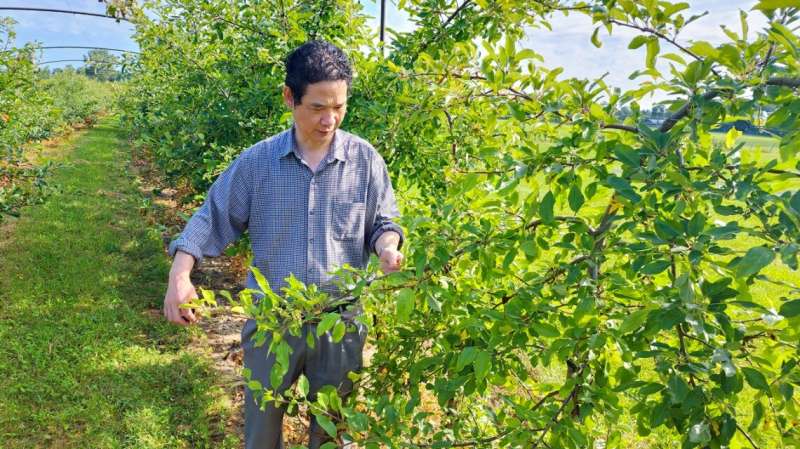This article has been reviewed according to Science X's editorial process and policies. Editors have highlighted the following attributes while ensuring the content's credibility:
fact-checked
trusted source
proofread
Gene variation makes apple trees 'weep,' improving orchards

Plant geneticists have identified a mutation in a gene that causes the "weeping" architecture—branches growing downwards—in apple trees, a finding that could improve orchard fruit production.
For more than a century, growers have tied down apple branches when trees are young, in order to improve crop productivity. More research is needed to understand the mechanism for why branch bending improves yields, but studies have shown that the practice helps apple trees allocate more resources such as carbon and other nutrients toward reproductive growth (flowering and fruiting) than toward vegetative growth (branches and leaves).
In rare cases, trees are known to naturally grow downwards.
The new study, published early release on July 3 in the journal Plant Physiology, identified a variation, or allele, of MdLAZY1A—a gene that largely controls weeping growth in apple.
"The findings presented in this paper could be used to make existing apple cultivars grow somewhat downwards and/or with more spreading branches, so they can be more productive, and it can save on labor costs of tying branches down," said senior author Kenong Xu, associate professor in the School of Integrative Plant Science Horticulture Section at Cornell AgriTech in the College of Agriculture and Life Sciences.
The mutation is rare, occurring in less than 1% of trees.
Now that the mutation—a single nucleotide substitution to the MdLAZY1A gene—has been identified, plant geneticists might use CRISPR/Cas-9 gene editing technology to develop cultivars with weeping-like growth, Xu said.
"We confirmed it through multiple transgenic studies," Xu said. "We put that allele in a standard royal gala apple cultivar and the tree grew downward."
To identify the gene, the researchers used a "forward genetics" approach, where they looked at the observable traits in more than 1,000 offspring of weeping cultivars, and separated those that exhibited weeping vs. normal growth. They then used advanced genetic sequencing techniques to compare the two populations to locate the genetic determinant.
Laura Dougherty, Ph.D. '19, a former postdoctoral researcher at Cornell and currently a research geneticist at the U.S. Department of Agriculture Agricultural Research Service, is the paper's first author. Co-authors include Susan Brown, professor in the School of Integrative Plant Science (SIPS) Horticulture Section at Cornell AgriTech, and Miguel Piñeros, adjunct associate professor in SIPS' Plant Biology Section.
More information: Laura Dougherty et al, A single amino acid substitution in MdLAZY1A dominantly impairs shoot gravitropism in Malus, Plant Physiology (2023). DOI: 10.1093/plphys/kiad373
Provided by Cornell University




















